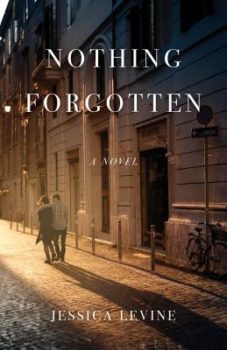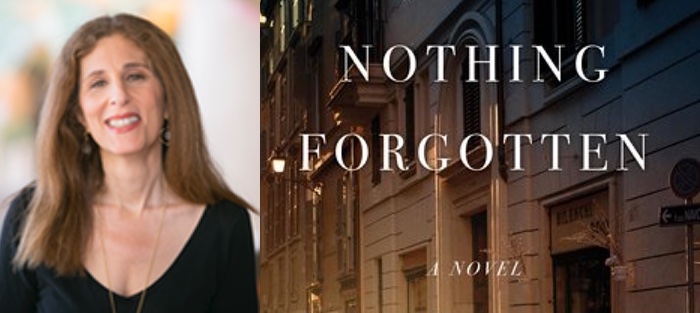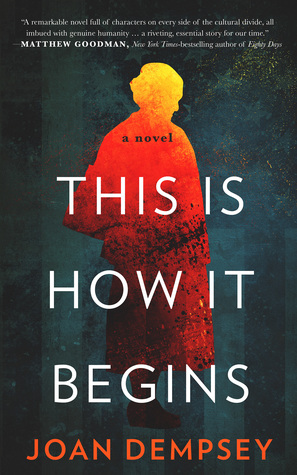Jessica Levine and I share a publisher, She Writes Press, and an agent, April Eberhardt. In the months leading up to the publication of my own novel, I remember noticing her first book, The Geometry of Love, a top-ten women’s fiction title in Booklist for 2015. I was drawn to it in part because, like Jessica, I share the experience of having attended school in French and having lived in Paris. There is a certain affinity authors have for each other when they have had similar experiences relating to place and language. I remember being struck by the fact that Jessica is also a translator, a skill I deeply admire, for I know that simply being multilingual is only one piece of the preparation that goes into translating the words, essence, culture, and feeling of a work from one language to another.
In Nothing Forgotten, we see Anna—wife, mother, not entirely satisfied with the way either of those roles has played out for her—receive an unexpected email from the Italian lover she knew decades before. The novel then takes us back to the 1980s and her youth in Rome and Paris. Jessica deftly paints a picture of a young woman desperate to escape her difficult childhood, navigating languages and cultures and threading her way between the dueling pulls of passion and reason.
Interview:
Anjali Mitter Duva: This book, like The Geometry of Love, involves two timeframes, and the ways in which a past relationship can return to destabilize the present. What has drawn you to this type of narrative?
Jessica Levine: In the age of Facebook and the internet, it’s easy to reconnect with friends and lovers from long ago. I know several people who have restarted relationships with ex-partners or intimate friends after decades of separation. It’s a fascinating phenomenon that raises all kinds of questions about identity and its transformation over a lifetime. So much learning and change can happen in twenty or thirty years that many people in middle age feel they are radically different from their younger selves. So how do these reconnections happen? When someone reconnects with an ex from youth, is she seeking some lost part of herself? Or is she reconnecting with something eternal within, the basic nature of her soul?
 Nothing Forgotten’s main character, Anna, is a compelling combination of rationality and impulsiveness. At times she reflects insightfully on her own condition and that of those around her, and yet she is reckless about following her heart and her physical desire. Did she come to you fully formed, or did she develop over the course of your writing the story? Was she the specific inspiration for the book?
Nothing Forgotten’s main character, Anna, is a compelling combination of rationality and impulsiveness. At times she reflects insightfully on her own condition and that of those around her, and yet she is reckless about following her heart and her physical desire. Did she come to you fully formed, or did she develop over the course of your writing the story? Was she the specific inspiration for the book?
There are both personal and literary sources to Anna’s character. She was partly drawn from my younger self and my experience living in Paris and Rome in my early twenties. (I should add here that she is a much-exaggerated version of that self and that the dramatic elements of the story are fictional). More generally, my fascination with irrational behavior on the part of intelligent people stems from my adolescence. Because I attended the Lycée Français in New York from first grade through high school, I was steeped in French literature at an early age and struck by the opposition between reason and passion in classical literature of the seventeenth century. In high school, we studied the embrace of honor over desire in the plays of Corneille and the tragic irrationality of passion in Racine. I was deeply impressed by a work often called the first psychological novel, namely Madame de Lafayette’s La Princesse de Clèves, in which the heroine chooses peace of mind (repos) over a life with her beloved. At the age of fifteen, I felt that reading these works was preparing for me the complexity of life.
My interest in irrational behavior on the part of intelligent people continued into adulthood. I still wonder, for example, how could someone as smart as Bill Clinton have gotten embroiled with Monica Lewinski? Psychologists suggest that most of our behavior and our decisions have unconscious origins. I believe this to be true.
The details you sprinkle throughout the book give the story a wonderful depth and texture. Many of your secondary and even minor characters, for example, are artists whose creative environment, process, and output you describe in very effective ways—Michael’s music, Linda’s sculptures, Dimitri’s exhibit of prints of antique dolls, Leila’s study of French engravings of women. I wonder how and where you found the inspiration for all of them, how you were able to render them all so well.
All the characters you mention have their origins in friends and relatives, some of whom were more successful than others in their artistic careers. For example, Linda, who is Anna’s mother, is partly based on my own mother, who was trained as an artist and was very talented, yet never able to realize herself as fully as she’d hoped. Her frustration was undoubtedly a contributing factor to her descent into alcoholism. The artist Dimitri is based on a well-known, scandalous French writer I knew when I lived in Paris during my youthful period abroad. He has only a minor role in Nothing Forgotten, but I had a lot of fun writing about him.
The story is set mostly in Italy—both in Rome and in a small town called Sperlonga—as well as in Paris. There is a long tradition of American writers in both France and Italy, yet Nothing Forgotten has its own, singular flavor, taking place in settings that are not the ones one most often sees in the English language. Could you tell us about your own experience in these countries, and what you have wanted to convey about them in your books?
Living abroad, I spoke both French and Italian well enough to “mix with the natives.” In Paris, I knew two French families that had me over for meals regularly. I had a job as an assistant English teacher at a high school in Nanterre, a rough working-class suburb, where I ate lunch every day with the teachers. In Italy, I often visited friends who lived in a gritty town not far from Rome. There I absorbed the culture of provincial Italy that informed my descriptions of Sperlonga.
At the same time my writing about Europe has been very influenced by Henry James, Edith Wharton, and my reading of European and Russian novels. The Russian infatuation with Paris as a beacon of civilization and the French infatuation with Italy as a land of beauty and chaos colored my perceptions of those places.
The book is full of engaging dialogue, with a cast of many characters. What is your approach to this notoriously tricky aspect of the craft? How do you write the first draft of dialogue, and what are your techniques for editing it? And how does the fact that many of the conversations would actually be taking place in other languages (Italian, French) play into your choice of words?
I actually find it easier to write dialogue than description. I “hear” my characters in my head and transcribe their voices, as though I were a medium for ghost entities.
I did spend a few years studying screenwriting and my experience writing screenplays proved useful later when I returned to fiction.
In elaborating Nothing Forgotten, I was helped by memories of an aunt who’d been born in Brooklyn and settled in Rome in her late twenties. When I lived there, she was in her fifties. After thirty years abroad, she not only spoke Italian fluently, but had transferred to English the sentence structures, idioms, and speech patterns of the Italian language, for example the way an affirmative sentence can end with a slight upbeat, as though it were a half-question. I can still hear her voice in my head, and it influenced the way I wrote the dialogue for the Italian-speaking characters.
Additionally, I had Italian friends whose voices I remember well. One pattern I transferred to English is the one whereby in Italian the subject of a sentence is often separated from the verb by a tiny pause then doubled. Thus, instead of writing, “Melitta isn’t curious about us,” I put: “Melitta, she’s not curious about us.”
Repetition in Italian happens with regard to content as well as syntax. In English, we can be rather business-like in our interactions and even get impatient with repetition. But in Italy, interlocutors repeat themselves simply to keep an exchange going because, as in Latin countries generally, conversation is used not only to transmit information but also to create personal connection and nurture relationships. This shaped some of the dialogues in my book.
You have translated books from Italian and French into English. How does your work in multiple languages affect your writing in English?
Being multilingual opens magical doors to other cultures, but there are pitfalls if you’re also a writer yourself. I’ve found that my command of prepositions and idioms in English is sometimes eccentric, having been “contaminated” by French (at the lycée in New York, all our subjects were in French, including math and science). I’m dependent on friends and editors to catch my missteps. On the other hand, my slippery grasp of “standard” English has opened the door to a greater willingness to bend and play with it.
Mostly, my work as a translator has led to more awareness about style and all the variations one can bring to it. This past year I translated a French memoir by Elie Paul Cohen, Mission Afghanistan: An Army Doctor’s Memoir, which is written with the concision you’d expect of a doctor. I also worked on an engaging Italian novel that uses stream of consciousness, experimental syntax, and ambiguity in inspiring ways. Translators are led into other linguistic patterns and rhythms that inevitably challenge their own. It’s a mental activity that hones creativity and mastery of one’s own language.
Could you tell us a bit about what you are working on now, and whether you plan to continue to explore similar themes and locations, or take us, and yourself, elsewhere?
My next novel will feature a cousin of Anna’s, Robin, who is a psychotherapist and shamanic practitioner living in San Francisco. There will be a focus not only on relationship but also on spirituality, ecological questions, and the role of the feminine in our struggle to save the earth. San Francisco, which has appeared on the edges of my first two novels, will move front and center. I love the Bay Area, which became my adoptive home in 1990, and am looking forward to exploring some of its subcultures in my next work.







